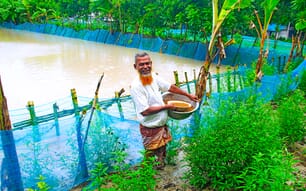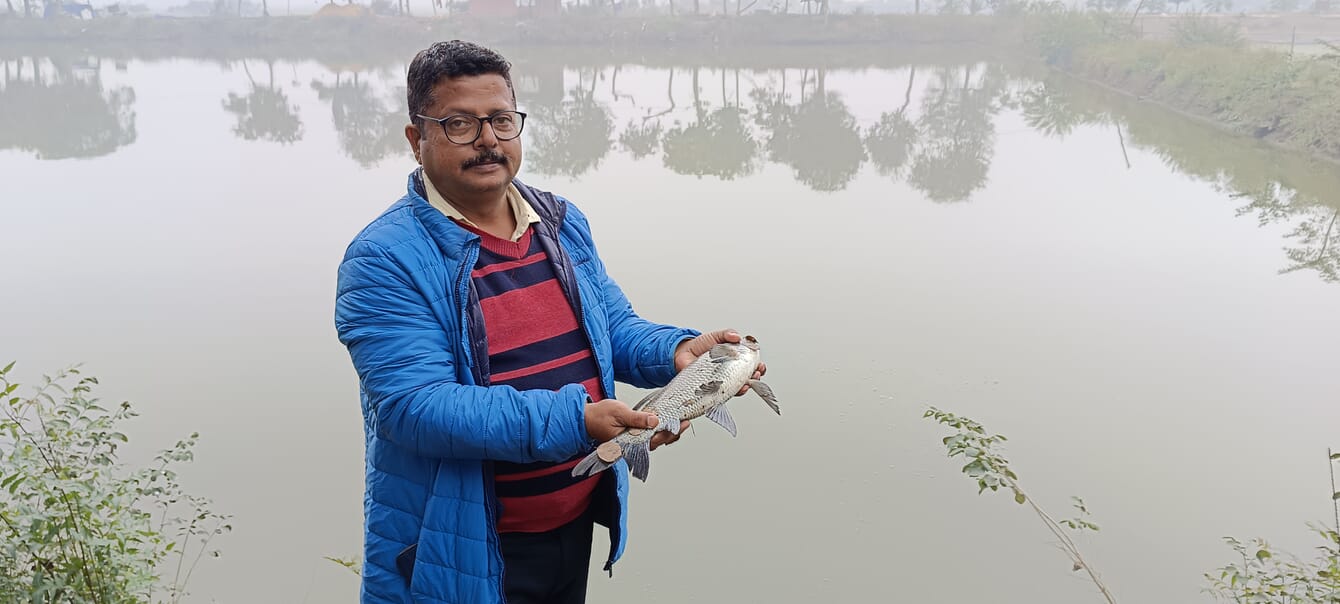
© Gurvinder Singh
What inspired you to embark on a career in aquaculture?
I hail from a farming family and was born in Bartharakalaon, a village in Chandauli district of Uttar Pradesh. My father grew rice and vegetables. I completed my Msc in maths but couldn’t complete my PhD in the same subject due to personal reasons.
I started working in road construction in 2007 and it helped me to earn a good income. However, I was not satisfied, due to massive corruption in the job and quit in 2012. I returned to my village but was severely criticised by my family for leaving such a lucrative profession.
I decided to excavate 2.13 hectares of my land into a pond for fish farming. My family was very angry, but I was determined to pursue my passion. Besides, I also wanted to offer livelihoods to locals who were migrating to other places in search of jobs. In 2013, I eventually started fish farming.
How challenging was it to start fish farming without any prior experience?
It was indeed very challenging on two fronts as I didn’t have any fish farming experience and secondly, the labourers were reluctant to join me in the fear of losing their jobs, due to my inexperience. I didn’t tell my family about my hardships.
Another major challenge was the removal of weeds from the pond that created problems for fish farming. I used to get in the pond and do the weed removal work but was bitten by leeches during this process. I didn’t inform the labourers about it, fearing that they might run away after hearing about them.
I used to return home every evening with several leeches on my body sucking my blood. My family was worried about my condition and told me that I had made a big mistake by leaving the lucrative work of a road contractor. But I refused to go back.
What is the size of the farm and what species do you operate?
I started with five ponds spread across 2.13 hectares in 2013 but now I have eleven ponds across 4.8 hectares. I operate traditional fish farming in ten ponds while one is for pond biofloc farming. I mainly deal in the Indian major carp (IMC) breeds of rohu (Labeo rohita) and catla (Labeo catla), as well as their cross breed.
I bought fry locally in the first year, but they were of very bad quality. Fortunately, I didn’t suffer losses but there was no profit either. I believe that in fish farming, you can only face losses if there is a theft. Otherwise, if you follow right measures by checking the water parameters, there are very few chances of losses in this sector.
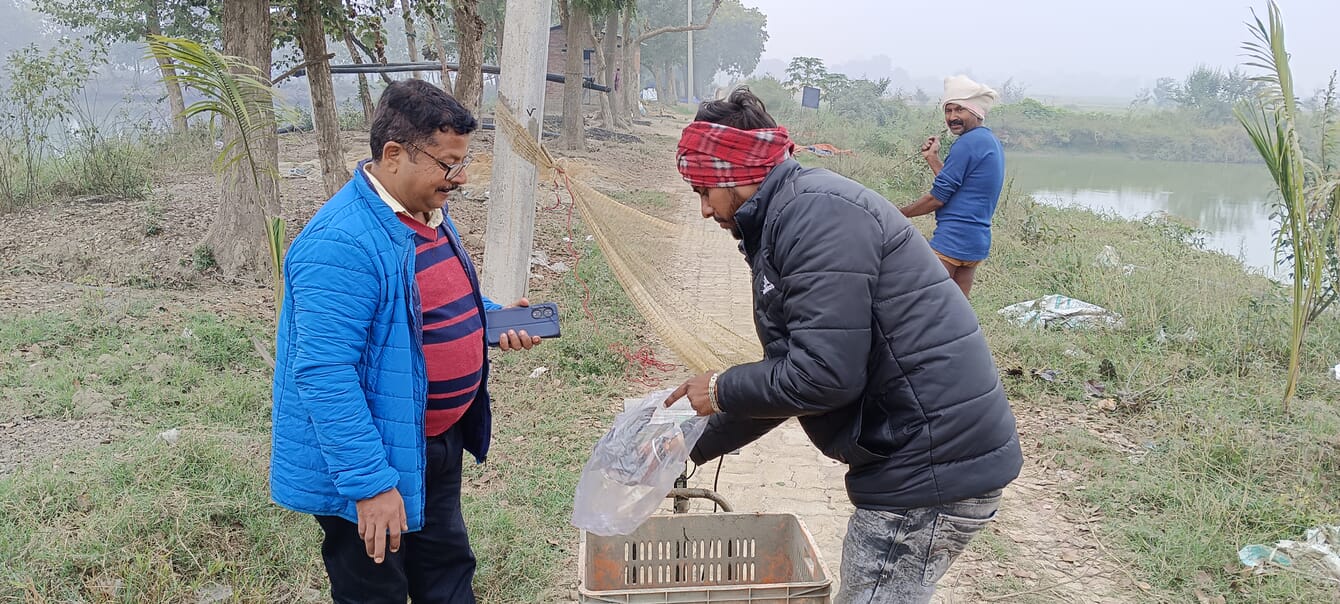
© Gurvinder Singh
When did you start making profit from aquaculture?
In 2016, I bought IMC juveniles and sold 4,000 kg of fish after they attained a weight of 1 kg each. It took 13-14 months to attain that size. I made a profit of Rs 3 lakhs INR ($3,609) from it. In 2017, I sold 6,500 kg of fish at the same size and made Rs 5 lakh profit ($6,020). I had also started pangasius farming in 2017.
What kind of feed do you provide to the fish?
I took the agency of a company that used to supply market feed in 2017 and became the supplier of feed in the entire Chandauli district. The feed was of high quality and my profits started increasing as the feed conversion ratio was good.
What is your mortality rate and how do you minimise disease?
The mortality rate is 5 percent and I use lime and alum to prevent disease.
What is your normal daily routine?
I have built my house close to the pond and wake up around 5.30 every morning and walk for at least an hour in the area encircling the ponds. This helps me to monitor the condition of the pond. I then instruct labourers about the quantity of feed to be thrown in the pond.
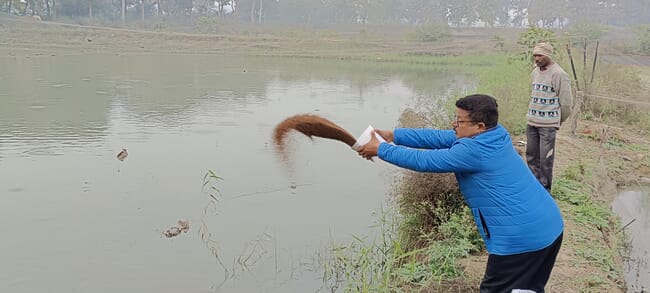
© Gurvinder Singh
Have you suffered any major loss in fish farming?
No, I have not suffered any major losses except the teething troubles I faced in my starting years.
What are the major problems you face in fish farming?
Weather fluctuations are a major problem as we suffer from extreme summer and winter conditions. The ideal temperature for fish farming is 28 to 34 degrees Celsius. But here temperature dips to 6 degrees in winter and 45 degrees in summer. We use ground water during winters to maintain temperature while in summers the breeze that flows helps to maintain the ideal temperature for fish farming.
Are there any individuals or departments who have particularly helped with your growth?
I am thankful to BN Singh, assistant director of fisheries, retired, Vikash Kumar, inspector in the fisheries department and NS. Rahmani, joint director, of the state fisheries department. They came to my village in 2020 and encouraged locals to start fish farming offering subsidies to them. The locals agreed and gave me additional land for fish farming on lease.
What equipment do you need for your farm?
I can increase my production but need aerators for it. The problem is with power supply for aerators, which is not regular in several parts of Uttar Pradesh.
What’s your biggest worry at work?
I remain worried about the quality of seed and feed as there are chances of suffering losses if they are not of good quality.
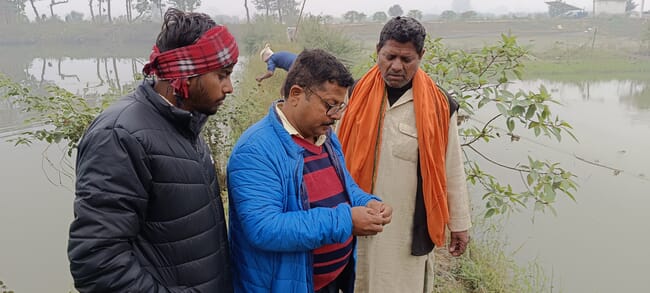
© Gurvinder Singh
What’s your annual fish production and revenue?
The annual fish production is 45,000 kg of IMC and 32,500 quintals of pangasius. My annual revenue is Rs 1.5 crore ($180,005).
What’s your ultimate ambition in this sector?
I want to increase production in the next five years so that our state becomes self-sufficient in fish farming and does not have to depend on other states. My aim is to provide live fish to every individual for consumption as fish mostly coming from states are dead.
Have you received any recognition for your work?
I have been awarded at both the district and state level for my contribution to the fishery sector. I am also the first farmer to start commercial aquaculture among the neighbouring 105 villages.
How are you contributing to society?
I have taken no formal training in fish farming, but constant monitoring helped me to learn about the process. I have started mentoring other fish farmers as my past experience helps me to guide them in a proper and scientific way. I have trained over 40 farmers in the district whom I provide with technical guidance and also provide them with feed and seed as well as regular assistance.
I have convinced many farmers that fish farming is more profitable than agricultural farming. Several people have started fish farming after being encouraged by my success. I advise them about the size of the pond to be dug, its depth, the quantity of juveniles to be used as most farmers hold the wrong opinion that more juveniles will lead to higher production. I also advise them of having nursery, semi-nursery and culture ponds for fish farming as it will help them to have multiple harvesting cycles.
What is your advice to budding fish farmers?
I advise people to venture into IMC farming as it provides a good profit. They should also focus on maintaining quality and avoid the use of antibiotics as it might hamper our export opportunities.


